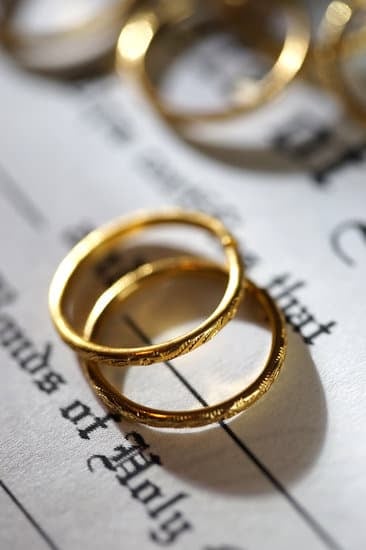Are you wondering which ring goes first, engagement or wedding? The order in which these rings are worn symbolizes different stages in the journey of love and commitment. In this article, we will explore the significance of both engagement and wedding rings, debunk the confusion about which one should be worn first, and provide insights into the cultural variations and modern trends associated with these timeless symbols of love.
Engagement and wedding rings have long been cherished as important symbols of love, commitment, and unity between partners. These pieces of jewelry hold deep meaning and tradition, representing the promise of a future together. The choice and order in which these rings are worn can carry significant emotional weight for many couples.
Throughout history, customs surrounding engagement and wedding rings have evolved to reflect changing social norms and cultural beliefs. Different materials, designs, and symbolism associated with these rings have also created distinct traditions. Understanding the significance of each ring within its historical context is crucial to fully appreciate their value in today’s society.
The Tradition of Wearing Rings
Engagement and wedding rings have been a symbol of love and commitment for centuries, with each ring holding its own specific significance. The tradition of wearing rings to symbolize one’s commitment dates back to ancient times, with the Egyptians believed to have been the first to use rings as a symbol of eternity. In ancient Rome, the tradition of giving an engagement ring was born, often made from iron to symbolize strength and permanence.
Throughout history, the materials and designs of engagement and wedding rings have evolved. Engagement rings traditionally feature a single gemstone, such as a diamond, to symbolize the uniqueness of the relationship, while wedding bands are often made of precious metals like gold or platinum, representing eternal love and unity. The symbolism of these rings has transcended through time and continues to hold significant meaning in modern society.
The decision of which ring goes first – engagement or wedding – is often a subject of confusion for many couples. Tradition dictates that the engagement ring is worn first, followed by the placement of the wedding band during the marriage ceremony. This symbolism represents the journey from courtship to marriage, with the engagement ring signifying promise and anticipation, while the wedding band represents unity and eternal love.
Difference Between Engagement and Wedding Rings
Engagement and wedding rings are both significant symbols of love and commitment, but they have distinct differences in terms of materials, designs, and symbolism. Engagement rings are typically adorned with a single diamond or gemstone, symbolizing the promise of a future together. On the other hand, wedding rings are often simpler in design, representing the eternal bond and commitment between two people.
In terms of materials, engagement rings are commonly made with precious metals such as gold or platinum and feature intricate settings to highlight the centerpiece stone. Wedding rings, on the other hand, are often made of more durable metals like tungsten or titanium, which are meant to withstand daily wear for years to come. The design of wedding bands may also include engravings or additional accent stones to personalize the ring.
Symbolically, engagement rings signify the beginning of a couple’s journey towards marriage, while wedding rings represent the lifelong union that follows. The placement of these rings on the finger also carries meaning: an engagement ring is traditionally worn on the fourth finger of the left hand, while a wedding ring is placed on that same finger after exchanging vows.
It is important to understand these differences in order to appreciate the significance of each ring in the context of a romantic relationship. Knowing which ring goes first – engagement or wedding – can help couples navigate traditions and customs as they embark on this meaningful chapter in their lives.
| Ring Type | Materials | Design | Symbolism |
|---|---|---|---|
| Engagement Ring | Precious metals like gold or platinum | Solitaire setting with a single diamond or gemstone | Promise of a future together |
| Wedding Ring | Durable metals like tungsten or titanium | Simpler design with engravings or accent stones | Lifelong union and commitment |
Which Ring Goes First
When it comes to the order of wearing engagement and wedding rings, there is often confusion about which ring goes first. This can vary depending on cultural traditions, personal preferences, and even modern trends. However, there are some general guidelines that can help clarify the issue and provide a clear answer to this common question.
Traditional Order of Wearing Rings
Traditionally, the engagement ring is worn first, followed by the wedding ring. The engagement ring is typically presented as a token of love and commitment when a couple decides to get married. It is then followed by the wedding ring, which symbolizes the official union and vows exchanged during the wedding ceremony.
Symbolism and Significance
The order in which these rings are worn also carries symbolic significance. The engagement ring signifies the promise and intention to marry, while the wedding ring represents the formal commitment made during marriage. By adhering to this traditional order, couples honor both their past decision to marry and their ongoing marital commitment.
Modern Trends and Personal Preferences
In modern times, there has been an increase in personalization when it comes to wearing engagement and wedding rings. Some individuals choose to wear both rings on their left ring finger at the same time, with either the engagement ring placed below or above the wedding band. Others opt for alternative placements or choose to switch up the order based on their own preferences or cultural influences.
Cultural Variations
In different cultures, the order in which one wears their engagement and wedding rings varies greatly, often influenced by tradition and local customs. For example, in Western cultures, the engagement ring is traditionally worn on the fourth finger of the left hand, followed by the wedding ring closer to the heart. This tradition dates back to ancient Roman times when it was believed that a vein in this finger ran directly to the heart.
On the other hand, in some Eastern European countries like Russia and Ukraine, wedding bands are typically worn on the ring finger of the right hand. In these cultures, the engagement ring is also worn on this finger before being moved to another finger or hand after marriage. In contrast, Jewish tradition dictates that both rings should be placed on the index finger during the ceremony before they are shifted to their designated fingers post-wedding.
It’s important to note that cultural variations can lead to some confusion as to which ring goes first – engagement or wedding? Understanding these differences helps in respecting and appreciating each culture’s unique traditions related to love and commitment. The exchange of rings isn’t just a romantic symbol; it encompasses various layers of history and tradition that are best approached with an open mind and appreciation for cultural diversity.
| Cultural Tradition | Order of Wearing Rings |
|---|---|
| Western Cultures | Engagement then Wedding Ring on left hand |
| Eastern European Cultures | Engagement then Wedding Ring on right hand |
| Jewish Tradition | Both rings initially placed on index finger during ceremony |
Modern Trends
When it comes to the question of which ring goes first, the traditional way is for the engagement ring to be worn first, followed by the wedding band. However, modern trends have led to alternative ways of wearing engagement and wedding rings. Couples are now exploring unique and personalized options that go beyond the traditional placement of the rings.
Here are some modern trends in wearing engagement and wedding rings:
1. Stacked Rings: Many couples opt for a stacked look, where both the engagement ring and wedding band are worn together on the same finger. This can create a stylish and eye-catching effect, especially when the rings complement each other in terms of design and style.
2. Separate Hands: Some couples choose to wear their engagement ring on one hand and their wedding band on the other. This allows each ring to stand out on its own and can be a meaningful way to symbolize different stages of the relationship.
3. Customized Designs: With access to custom jewelry designers, couples are creating unique combinations of engagement and wedding rings that suit their personal style. Whether it’s incorporating birthstones, engraving meaningful dates or symbols, or mixing different metals, customized designs allow for a more individualized approach to wearing these special rings.
These modern trends reflect a shift towards personalization and creativity in how couples choose to wear their engagement and wedding rings. Ultimately, there is no right or wrong way to wear these symbols of love and commitment – it’s all about what feels meaningful for each individual couple.
Etiquette and Customs
Wearing both engagement and wedding rings comes with its own set of etiquette and customs that have been followed for generations. It is important to understand the dos and don’ts of wearing these significant pieces of jewelry, as they are representative of love, commitment, and the union between partners.
Keeping the Rings Clean and Well-Maintained
One important aspect of wearing engagement and wedding rings is keeping them clean and well-maintained. These rings hold sentimental value and should be treated with care. It is advised to regularly clean them to maintain their shine and sparkle. Additionally, getting them inspected by a jeweler periodically can help prevent any damage or loss of stones.
Proper Placement on the Ring Finger
Traditionally, the engagement ring is worn closer to the hand, followed by the wedding ring. The wedding band is placed on the finger after marriage during the exchange of vows to symbolize eternal love and devotion. This order holds significance in many cultures around the world.
Respecting Cultural Differences
It is important to be mindful of cultural differences when it comes to wearing engagement and wedding rings. In some cultures, such as in parts of Europe, it is customary to wear the wedding band first before receiving an engagement ring. Understanding these variations in customs can help individuals navigate through different traditions respectfully.
Overall, understanding the proper etiquette surrounding engagement and wedding rings is essential in showcasing respect for each other’s cultures while honoring traditions that hold sentimental value. These symbols of love and commitment should be treated with care and respect which ring goes first engagement or wedding without compromising personal preferences or cultural practices.
Conclusion
In conclusion, the tradition of wearing both engagement and wedding rings holds great significance in symbolizing love, commitment, and the union of two individuals. The engagement ring marks the beginning of a couple’s journey towards marriage, while the wedding ring signifies their lifelong commitment to each other. Both rings carry immense sentimental value and serve as constant reminders of the bond shared by a couple.
The debate on which ring goes first, the engagement or wedding ring, has been ongoing for years. However, it is important to remember that there is no right or wrong answer. It ultimately comes down to personal preference and cultural traditions.
Some may choose to wear the engagement ring first as a symbol of promise and then add the wedding ring during the ceremony, while others may prefer to wear both rings together from the start. What truly matters is the love and commitment that these rings represent, regardless of their order.
As times change and cultures vary, there is an evolution in how engagement and wedding rings are worn. Modern trends have emerged where couples opt for alternative ways of displaying their commitment through unique ring designs or unconventional placement on different fingers.
Despite these changes, one thing remains constant – these rings serve as tangible symbols of everlasting love and dedication to one another. Ultimately, whether one chooses to wear their engagement or wedding ring first, what matters most is the love and commitment they hold for each other.
Frequently Asked Questions
Do You Wear Your Wedding Band on Top or Bottom?
The tradition of wearing the wedding band on top or bottom varies depending on cultural and personal preferences. In many Western cultures, the wedding band is traditionally worn on the bottom, closest to the heart.
However, in some other cultures, it may be worn on top. Ultimately, it’s a matter of personal choice and what feels most comfortable for the individual.
Do You Wear the Engagement Ring Before Marriage?
It is common for individuals to wear the engagement ring before marriage. The engagement ring is typically given at the time of the proposal and is worn as a symbol of commitment and love leading up to the wedding day. Once married, both the engagement ring and wedding band are often worn together as a set.
Do Engagement Rings Go on Left or Right?
The tradition of wearing an engagement ring on either the left or right hand varies based on cultural and regional customs. In many Western countries, such as the United States and Canada, it is common to wear the engagement ring on the left hand.
However, in countries like Germany and Russia, it may be worn on the right hand instead. Ultimately, it comes down to individual preference and local traditions when deciding which hand to wear an engagement ring on.

I have been involved in marriages for over 20 years helping couples and singles understand more about them.





